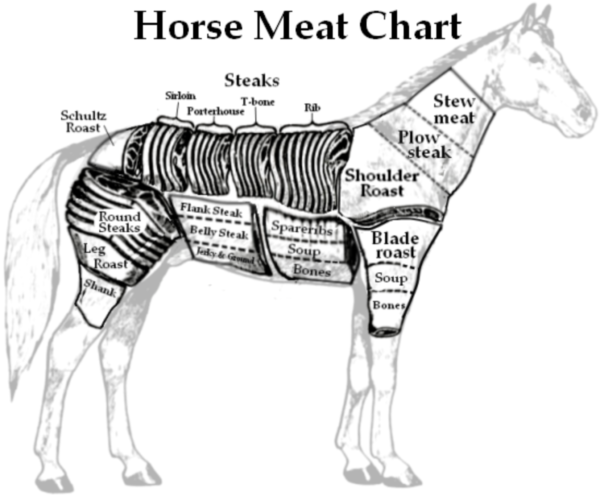Hello ladies and gents this is the Viking telling you that today we are talking about
What’s Wrong With Eating Horse Meat?
At some point, we’ve all remarked without really meaning it that we were so hungry we could eat a horse; now, across Europe, thousands of consumers are facing the reality that they may have unwittingly done so. “Burgergate”—as it has come to be known—first broke last month when researchers in Ireland found equine DNA in processed beef destined for delivery across the United Kingdom. Traces of horse have since been found in beef products in other EU countries, including Germany, the Czech Republic and Romania. And yesterday, food giant Nestle was forced to pull several varieties of frozen pasta meals from the shelves of stores in Spain, France and Italy after they were found to contain horse.
The consumer outrage in Europe echoes last year’s “pink slime” scandal here in the U.S. But unlike pink slime, which is a chemically treated byproduct with all the gastronomical appeal of Soylent Green, horse meat has served as a wholesome—and I’m told delectable—source of protein for centuries.
Of course, no one wants to eat mislabeled food, but our revulsion to eating horse goes further than that. Today, even those of us who will gladly dine on rabbit pot pie or pigeons rôti are averse to the idea of an equine feast. But it hasn’t always been that way. And, as Victor Fiorillo reports on Foobooz, it may not always be, thanks to at least one adventurous Philly restaurateur who is planning to put horse back on the menu.
Before you dig in, here are five facts about the other “red meat”:
During WWII, Lots of Americans Ate Horse
During WWII, as rationing made it more difficult for families to find beef, American butchers across the country sold horse meat, and consumers literally ate it up. Republican leaders, eager to use the new equine diet to embarrass President Truman, took to derogatively calling him “Horsemeat Harry.” As this 1942 Pittsburgh Press article suggests, Philadelphians were denied the pleasure of eating horse due to a state law. At roughly half the cost of beef, horse was served as a protein supplement until well after the war in some places, though. Time reported that during the inflationary years of the early 1970s, a butcher shop in Connecticut was wholesaling about 6,000 pounds of horse meat every day.
Blame Christians for Taboo on Eating Horse Meat
The Old Testament contains no specific proscription against the eating of horses; and it wasn’t until 723 A.D., under the reign of Pope Gregory III that the eating of horses was designated a “filthy and abominable custom,” reflective of paganism. Under the Irish “Collectio canonum Hibernensis”—a collection of canonical laws from the eighth century—eating a horse was punishable by three-and-a-half years of a near starvation diet of bread and water. Islamic scholars differ on the subject, with some saying horse meat is acceptable, while others regard it not as forbidden, but discouraged (mostly because of the utilitarian function of horses).
President Obama Re-Legalized Horse Slaughter
Slaughtering horses for human consumption was illegal until 2011, when President Obama signed a bill lifting a five-year ban that had kept federal inspectors out of slaughterhouses. According to David Duquette, president of the United Horsemen, which lobbied for lifting the prohibition, prior to the ban, meat (most all of it for export) made up 80 percent of the more than $100 billion a year horse-processing industry. There were just three horse-processing plants in the continental U.S. prior to 2007; today there are none. Shortly after the ban was lifted, New York restaurateur Hugue Dufour served 5,000 grilled-cheese sandwiches made with horse-and-pork bologna at a food festival in Brooklyn. However, he was forced to nix plans to add French-style horse meat tartare to his restaurant’s menu (with meat imported from Canada) due to outcry from local animal activists.
Eating Horse Meat Is So Ivy League
Until the mid-1980s, horse steaks held a revered place on the menu of the Harvard Faculty Club. A 1965 article in the Harvard Crimson describes a brief dry period, when supply issues temporarily disrupted access to the then-$2 dish, which was reportedly prepared “chicken fried” with a mushroom sauce. According to lore, horse was removed from the menu in 1985, not because of lack of demand, but because the Faculty Club’s new French chef refused to prepare meat that had been previously frozen.
Eating Horse Meat Is Good for You
That’s right. Horse meat is not only high in protein, but a good cut has about half the fat, less cholesterol and twice as much iron and Vitamin B as beef. It also contains fewer calories, and a significantly higher omega-3 fatty acid concentration (that’s the good fat)—with 360 mg per 100 grams serving, compared to just 21 mg in a beef steak
And as always have a chilled day from the Viking

Comments
Post a Comment